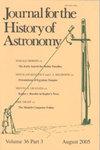Investigating calendrical methods of calculating sunrise and sunset times in the Shixian calendar
IF 0.3
3区 哲学
Q3 HISTORY & PHILOSOPHY OF SCIENCE
引用次数: 1
Abstract
The Shixian calendar is the general name for Chinese calendars implemented in China’s Qing dynasty (1636–1912) and Korea’s Joseon dynasty (1392–1910). This calendar made under the influence of Western sciences was revised several times. Referring to the Yuzhi lixiang kaocheng, compiled by Mei Juecheng et al. in 1724, we analyze calendrical methods employed in the Shixian calendar for calculating sunrise and sunset times in terms of astronomy and mathematics. In astronomy, the Polaris was used to measure the latitude, and the Sun’s diurnal parallax was considered to increase accuracy. In mathematics, Western mathematics, such as trigonometric functions and properties of similar spherical triangles, were used to calculate sunrise and sunset times. In addition, ready reckoner tables were used to obtain the trigonometric values. The reproduced sunrise and sunset times are compared the results recorded in Shixian annual almanacs published in China and Korea to obtain the rules regarding dates on which these recording were made in the almanacs. We find that sunrise and sunset times were changed before and after around 1726 and in 1728 in the Shixian almanacs of China and Korea, respectively. Furthermore, we verify the values of the latitude and obliquity of the ecliptic used for calculating the sunrise and sunset times in the almanacs in each dynasty. This study will help understand the Shixian calendar and its annual almanacs in China and Korea.石县历计算日出日落时间的历法方法研究
世贤历是中国清朝(1636–1912)和朝鲜王朝(1392–1910)使用的中国历法的总称。这本受西方科学影响而制作的历法被修改了好几次。参考梅觉诚等1724年编著的《舆志·理象考程》,从天文学和数学两个方面分析了《世贤历》中计算日出日落时间的历法方法。在天文学中,北极星被用来测量纬度,太阳的日视差被认为可以提高精度。在数学中,西方数学,如三角函数和类似球面三角形的性质,被用来计算日出和日落时间。此外,还使用现成的计算表来获得三角值。将再现的日出和日落时间与中国和韩国出版的石县年历记录的结果进行比较,以获得这些年历记录日期的规则。我们发现,在中国和韩国的世贤历书中,日出时间和日落时间分别在1726年前后和1728年发生了变化。此外,我们还验证了每个朝代历书中用于计算日出和日落时间的黄道纬度和倾角的值。这项研究将有助于了解中国和韩国的世贤历及其年历。
本文章由计算机程序翻译,如有差异,请以英文原文为准。
求助全文
约1分钟内获得全文
求助全文
来源期刊

Journal for the History of Astronomy
地学天文-科学史与科学哲学
CiteScore
0.50
自引率
25.00%
发文量
44
审稿时长
>12 weeks
期刊介绍:
Science History Publications Ltd is an academic publishing company established in 1971 and based in Cambridge, England. We specialize in journals in history of science and in particular history of astronomy.
 求助内容:
求助内容: 应助结果提醒方式:
应助结果提醒方式:


